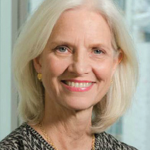Dr. Harrington served the rheumatology community through his work with the American Society for Bone and Mineral Research, the Consortium of Rheumatology Researchers of North America, the Rheumatoid Arthritis Practice Performance Project and the ACR, where he was recognized for his outstanding contributions with the Paulding Phelps Award (1993), Master Designation (2003) and the Distinguished Clinician Scholar Award (2019).
William Arnold, MD; Tim Bartholow, MD; Drew Johnson, MS, MBA; Joel Kremer, MD; Daniel Malone, MD; Eric D. Newman, MD; Kenneth Saag, MD; and Douglas White, MD, all contributed to the development of this remembrance.
A Eulogy for J. Timothy Harrington, MD
By Eric D. Newman, MD
Tim and I met through circumstances I don’t remember. Somehow his interests and mine intersected about 20 years ago at an ACR meeting, and we connected. Literally, but also figuratively. Within seconds, we realized we were twin sons of different mothers—both passionate about redesigning care for those we serve, our patients. At that fateful moment, a mentorship, a partnership and an everlasting friendship were simultaneously born.
Tim was several decades ahead of his time. He developed one of the first osteoporosis care programs, focusing on ensuring the right care happened reliably, instead of falling into what he referred to as the Bermuda Triangle of osteoporosis care. A decade or two later came the concept of a fracture liaison service (FLS), which is now a nationally accepted care delivery process operationalized across the country. Tim did it first.
A second example is pre-appointment management. Tim understood before many of us were out of diapers that if you reviewed the correct information prior to blindly scheduling a patient, you could actually get the right patient the right care in the right venue at the right time. That work was published 19 years ago. And that very concept has been learned and relearned and redone a thousand different ways by access mavens, but it all links back to the seminal work Tim put out there.
Enough of his prowess—I want to focus on what Tim’s relationship has meant to me personally. Tim and I worked together on several ACR committees, where I quickly learned that Tim pretty much knew more than anyone else in the room and was not at all afraid of explaining why the traditionalist approach that was advocated would fail and why other alternatives were more viable.
The funny thing is, I was often the only other one in the room who seemed to get it. It was like our brains were somehow wired with the ability to see things not for what they are, but what they could be, the ability to simplify and the passion to challenge oneself with the mantra, “There’s always a better way.” Change was not hard for Tim and me. We ate it for breakfast, lunch and dinner.



